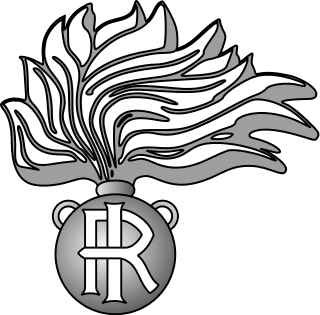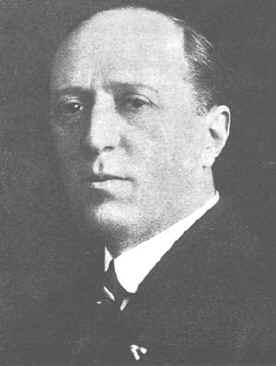
The Carabinieri are the national gendarmerie of Italy who primarily carry out domestic and foreign policing duties. It is one of Italy's main law enforcement agencies, alongside the Polizia di Stato and the Guardia di Finanza. As with the Guardia di Finanza but in contrast to the Polizia di Stato, the Carabinieri are a military force. As the fourth branch of the Italian Armed Forces, they come under the authority of the Ministry of Defence; for activities related to inland public order and security, they functionally depend on the Ministry of the Interior. In practice, there is a significant overlap between the jurisdiction of the Polizia di Stato and Carabinieri, although both of them are contactable through 112, the European Union's Single Emergency number. Unlike the Polizia di Stato, the Carabinieri have responsibility for policing the military, and a number of members regularly participate in military missions abroad.
Brigadier general or brigade general is a military rank used in many countries. The rank is usually above a colonel, and below a major general or divisional general. When appointed to a field command, a brigadier general is typically in command of a brigade consisting of around 4,000 troops.

A commander-in-chief or supreme commander is the person who exercises supreme command and control over an armed force or a military branch. As a technical term, it refers to military competencies that reside in a country's executive leadership, a head of state, head of government, or other designated government official.

The chairman of the Joint Chiefs of Staff (CJCS) is the presiding officer of the Joint Chiefs of Staff (JCS). The chairman is the highest-ranking and most senior military officer in the United States Armed Forces and the principal military advisor to the president, the National Security Council, the Homeland Security Council, and the secretary of defense. While the chairman of the Joint Chiefs of Staff outranks all other commissioned officers, the chairman is prohibited by law from having operational command authority over the armed forces; however, the chairman assists the president and the secretary of defense in exercising their command functions.

Ugo Cavallero was an Italian military commander before and during World War II. He was the first Chief of the Comando Supremo on June 1941. He was dismissed from his command due to his lacklustre performance, and was arrested upon the fall of Benito Mussolini's regime. Cavallero was later freed by the Germans, but refused to collaborate and was found dead the following day.
In the United States military, a general is the most senior general-grade officer; it is the highest achievable commissioned officer rank that may be attained in the United States Armed Forces, with exception of the Navy and Coast Guard, which have the equivalent rank of admiral instead. The official and formal insignia of "general" is defined by its four stars.
In the United States Armed Forces, a lieutenant general is a three-star general officer in the United States Army, Marine Corps, Air Force, and Space Force.
An army corps general or corps general is a rank held by a general officer who commands an army corps. The rank originates from the French Revolutionary System, and is used by a number of countries. Normally, the rank is above the divisional general and below the army general, so it usually corresponds to the lieutenant general. However, in some countries such as Spain, Brazil, and Peru, the rank of army corps general is not used, in Spain the rank of army corps general is replaced by the rank of lieutenant general, while in some countries such as Brazil and Peru, the rank of army general is immediately above that of divisional general.
Divisional general is a general officer rank who commands an army division. The rank originates from the French Revolutionary System, and is used by a number of countries. The rank is above a brigade general, and normally below an army corps general.

A five-star rank is the highest military rank in many countries. The rank is that of the most senior operational military commanders, and within NATO's standard rank scale it is designated by the code OF-10. Not all armed forces have such a rank, and in those that do the actual insignia of the five-star ranks may not contain five stars. For example: the insignia for the French OF-10 rank maréchal de France contains seven stars; the insignia for the Portuguese marechal contains four gold stars. The stars used on the various Commonwealth of Nations rank insignias are sometimes colloquially referred to as pips, but in fact either are stars of the orders of the Garter, Thistle or Bath or are Eversleigh stars, depending on the wearer's original regiment or corps, and are used in combination with other heraldic items, such as batons, crowns, swords or maple leaves.

The Ministry of Defence is the government body of the Italian Republic responsible for military and civil defence matters and managing the Italian Armed Forces. It is led by the Italian Minister of Defence, a position occupied by Guido Crosetto since October 2022.

Ubaldo Soddu was an Italian general and politician who held the position of Deputy Chief of Staff of the Army and Undersecretary of State for War during the initial phases of World War II. On 13 June 1940, immediately after the outbreak of hostilities with France and the United Kingdom, he assumed the position of deputy chief of the General Staff. Promoted to army general, he replaced general Sebastiano Visconti Prasca as commander of the Albanian Higher Troop Command during the Greco-Italian War on 8 November 1940. Because of the defeat Italian troops suffered between 22 and 23 November 1940, he was replaced after four weeks in command by the Italian Royal Army's chief of staff, General Ugo Cavallero.

Sebastiano Visconti Prasca was an Italian general. A veteran of the Italo-Turkish War of 1911–1912 and World War I, he led the initial offensive of the Greco-Italian War in 1940 during World War II, but was relieved of his command after two weeks for incompetence and relieved by General Ubaldo Soddu.

Christophe Prazuck is a French naval officer. He was promoted to amiral and appointed the Chief of Staff of the French Navy on 13 July 2016.
Army general was a military rank of the Kingdom of Serbia and later Kingdom of Yugoslavia. Established in 1900, it was abolished for some period after 1901, but it was again created in Kingdom of Yugoslavia after 1918 as Kingdom of Serbia passed along insignia and military ranks to newly named state. It was a high rank for Yugoslav generals, inferior only to the Vojvoda. Yugoslav army generals commanded armies, group of armies and held position of Deputy Commander in Chief of the Yugoslav Armed Forces, Chief of the Royal Yugoslav Army Air Force and Chief of the General Staff of the Royal Yugoslav Army. It was adopted and based on the similar French "commandant d'armée" later known as "général d'armée " - Army general.

Miguel Ángel Villarroya Vilalta is a Spanish Air and Space Force general who served as the 11th Chief of the Defence Staff of Spain from 2020 to 2021. Before this, from 2017 to 2020 he was the Chief of the Technical Cabinet of the Defence Ministers María Dolores de Cospedal (2017–2018) and Margarita Robles (2018–2020).

Francesco Paolo Figliuolo is an Italian army corps general. On 1 March 2021, he was appointed by Prime Minister Mario Draghi as Extraordinary Commissioner for the Implementation of Health Measures to Contain the COVID-19 pandemic, to lead the vaccination campaign.

Melchiade Gabba was an Italian general during the Fascist period, who served as commander of the Royal Corps of Colonial Troops of Eritrea and Chief of Staff of the East Africa High Command during the Second Italo-Ethiopian War. From 27 July 1943 to 24 February 1944 he was Minister of Italian Africa of the Badoglio I Cabinet. He was also a Senator of the Kingdom of Italy from 1939 to 1944.













